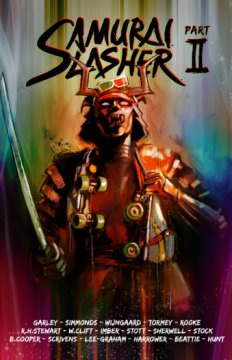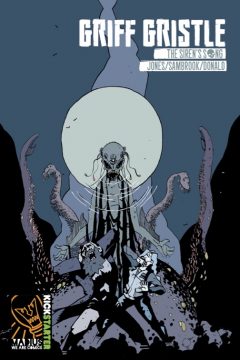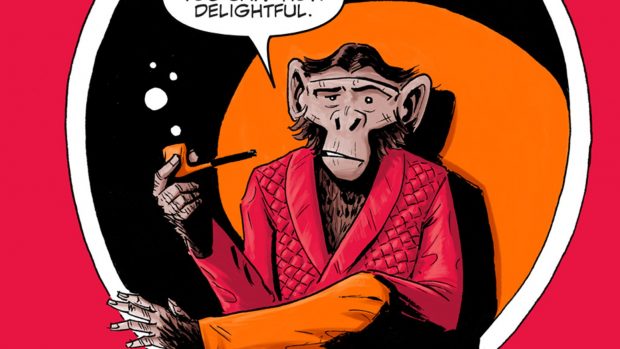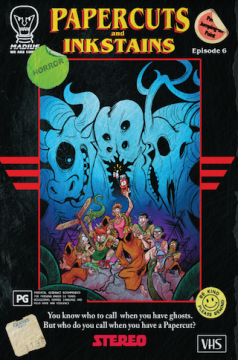How to fund an indie comic on Kickstarter – our experts guide!

Kickstarter is the new shop window for indie comic creators, with dozens of titles funded every week. But how do you get people to invest in the promise of your amazing new small press or indie comic? We talk to the UK scene’s Kickstarter experts to get their essential tips on how to fund an indie comic and run a winning campaign…
#1 BE PREPARED
Mike Garley: “You need to be super- organised and prepared for what will be an extremely stressful and full-on method of funding!”

Jon Laight: “I start preparing Kickstarter campaigns at least six months before the launch date. It starts with a rough date of when I’d like to launch and this has lots to consider in itself. Time of year, month or week can all have a big impact on when and who will support your project.”
Ken Reynolds: “Have a finished product before you start, it’s much easier to sell.”
Rob Jones: “We created infographics and easily shareable pictures to make sure the most info was available, and to try and maximise impact. We contacted podcasts and reviewers to get the information out there, then told our friends, families and followers. I also think our countdown was a bonus, as, in its own small way, it helped build up anticipation for the kickstarter, and drum up a little fanfare.”
Mike Sambrook: “These campaigns are a lot of work and it’s good to know in advance exactly what you’re getting yourself into and have all of your ducks in a row. Another tip is try and minimise the risk to your customers. We pledge to make sure we are nearly finished with a project by the time it hits crowdfunding, that way we know we can deliver on our promises. Kickstarter relies on a trust and we want to make sure people know they can rely on our campaigns to deliver in a timely fashion.”
#2 WORK OUT YOUR PRICING & COSTS

Jon Laight: “Your target should be realistic and justi able to people who might not understand how much these things can cost.”
Chris Welsh: “Don’t expect to be paid. You’re aiming to break even, at best. Don’t try to do too much at once – kickstarting a 17-part series in one go is probably not going to happen.”
Ken Reynolds: “Get print quotes, I recommend Comic Printing UK. You may need to make the pages slightly smaller to get a better price. Look into different quantities, the more you print the better the unit cost etc. and work out the production costs of any extra rewards you want to offer (postcards, prints etc) Then pick a number of backers you think is achievable. I usually start with 100, for a first campaign it’s good going. Divide your costs by 100 to work out the average spend you need each backer to make.
Keep the target as small as you can without running the risk of losing money. You can’t predict how many backers you’ll get, but you have to set it up that if you get more than expected it won’t incur more costs.
#3 DON’T FORGET POSTAGE
Rob Jones: Don’t miscalculate your postage and packaging…which is exactly what we did! Ha!
 Mike Sambrook: “That really has a way of creeping up on you and we’ve been stung by that one in the past. For the prices we ended up paying to get Griff Gristle to people we’d have predicted we’d have been able to fly an elephant to Mars (in first class, no less). Always check these things with your local post office in advance!
Mike Sambrook: “That really has a way of creeping up on you and we’ve been stung by that one in the past. For the prices we ended up paying to get Griff Gristle to people we’d have predicted we’d have been able to fly an elephant to Mars (in first class, no less). Always check these things with your local post office in advance!
Ken Reynolds: “Try to emulate your biggest reward package, make it up in an envelope and weigh it. Then look up postage costs. UK & International. Assume 50/50 split on UK & Int backers and average out the costs. Add this to your total. Then add another 10% to that total for Kickstarter costs. That’s the final target. Now divide it by 100 again and see if it’s a reasonable number for someone to spend on 1 comic + extra rewards + postage. If it’s a lot, rethink a few things. Smaller print run, less rewards etc.
#4 YOU HAVE TO RUN A CAMPAIGN
Ken Reynolds: There is no right way to work it all out. It will always feel like you’re running a risk because there are so many variables.
Mike Garley: ”I try to make sure that my project is accessible to people who don’t know about me or my work – Kickstarter backers are the biggest chunk of backers (compared to twitter followers, referrals through articles, etc…) so it’s vital that your project is clear and engaging enough to stand out from the crowd.”
 Grainne McEntee: ”Go in with eyes wide open. Don’t look at your creation through rose-tinted glasses. There is a lot of great stuff on the creator-owned scene right now and you have to push yourself that little bit harder and further if you want to hit your goals.”
Grainne McEntee: ”Go in with eyes wide open. Don’t look at your creation through rose-tinted glasses. There is a lot of great stuff on the creator-owned scene right now and you have to push yourself that little bit harder and further if you want to hit your goals.”
Chris Welsh: “Be sensible and realistic in your target and what you’re offering. Ask for the minimum you need to make the book. Prepare to put the work in. Make sure the KS page looks professional, doesn’t have any silly typos, and actually tells readers what they can expect. Take a look at successful pages, and compare them to unsuccessful ones
– learn from the success and mistakes that others have made.”
Ken Reynolds: “It’s fun when you get into it though, and I genuinely think it’s a great way to help a book nd and build an audience.”
Grainne McEntee: “I don’t think we would do another March KS as everyone seemed to have the same idea there (Christmas is not a good time, holidays, other commitments, etc) and we ended up vying for attention against 180+ other comic book crowdfunders so we really had to stay on top of it.”
#5 MAKE A GREAT VIDEO
Jon Laight: “A good video can convince people to firstly stop and check your page out and then back your project. Boring, uninspiring videos will just turn people off. I used iMovie on my latest campaign to give it a more of a movie trailer feel before peopled to listen to my shocking Brummie accent.
Grainne McEntee: The videos have been a real boon [for Bubbles O’Seven]. Matt’s experience in video animation brought a slickness and appeal that would otherwise have been absent and as we made the target on the last one, I know it was very much thanks to the videos. Views were consistently high with more than 60% watching the whole thing, and it certainly got a fair bit of traction on social media, a decent percentage of backers coming through via Facebook for the second KS.

Matt Rooke: Video is a proven attention grabber for online marketing, so the first thing we consider (after the book itself!) is how to approach the video. We’ve tried to avoid the “piece to camera” approach, and instead give Bubbles himself a voice. With the title being (mostly) a spy comedy, we can draw on familiar tropes and ideas, such as the James Bond title sequences, and they lend themselves to an animation approach. We also try to make people laugh, which I think helps. Length of the video is really important – I’ve seen so many KS videos that waffle on for 5 or even 10 minutes. The trick is to keep it succinct and aim for around 90 seconds. Certainly no more than 2 mins. You’d be surprised at how much you can get across in that time.”
#6 PROMOTE IT!
 Jon Laight: “Getting ready for some hard work: If you look at nearly all Kickstarters, you can tell who has put the hard work in. On rare occasions, the artwork and the name of a person can sell a book all by itself but for most of us its going to be late nights, numerous retakes of video clips and a lot of file uploading!
Jon Laight: “Getting ready for some hard work: If you look at nearly all Kickstarters, you can tell who has put the hard work in. On rare occasions, the artwork and the name of a person can sell a book all by itself but for most of us its going to be late nights, numerous retakes of video clips and a lot of file uploading!
Ken Reynolds: It’s a month long slog of shouting the same thing… You will get a few people that just browse KS anyway and will find you. You need a social media presence and audience to start with otherwise you’re promoting to nobody. Get in touch to blogs and review sites to help promote. Post in comic groups on facebook etc.
Mike Garley: You need to plan promotion to try and keep people interested for the entire length of your campaign. That’s probably the toughest aspect of running a campaign. That and the soul-destroying self-doubt…
#7 COMMUNICATE WITH BACKERS
Jon Laight: Be passionate: If you can show passion for your creation, people will be more likely to get behind you. Make it personal, tell them what has led up to this point and be yourself…don’t be afraid to show your sense of humour or the other feelings behind it all.
Ken Reynolds: Offer digital rewards, as international backers may like the project but can’t afford the postage. Offering a £1 digital comic is all the rage at the moment, hoping for volume of people rather than value. Plus the idea is to get as many people to read as possible.
 Jon Laight: Once you hit your target its not just beers and tears!! Keep potential backers interested by offering further goodies and value and the guys and girls who have already joined your journey get even more for what they’ve already pledged for.
Jon Laight: Once you hit your target its not just beers and tears!! Keep potential backers interested by offering further goodies and value and the guys and girls who have already joined your journey get even more for what they’ve already pledged for.
#8 STRETCH GOALS
Rob Jones: Stretch goals needs to be something that everyone who’s backed can bene t from, a shared sense of satisfaction that a project you’ve helped bring to life rewards all of you equally for bringing it into the world. We added
a whole epilogue to Griff, as it seemed like a great way to both expand upon the story and reward every backer for helping us bring that salty sea dog to life!
Mike Sambrook: Yeah, it’s nice to make the stretch goals feel like a reward to everyone who’s helping to bring this product to life. Then, from a boring business perspective something that is easily scalable. As you will be providing the stretch goals (in most cases) to all of your backers you need to make sure that whatever it is won’t end up costing more to produce than the pledges themselves.
Jon Laight: Make it the best it can be and try to show it off as much as possible. The rest should support your comic…not overpower it.
#9 DELIVER ON YOUR PROMISES
 Jon Laight: Figure out what you want: If its pro ts you’re after, Kickstarter may not be for you. If I can break even at the end of the campaign I’m happy. I try to get as many printed as possible (another thing you should try to do, the more you get, the cheaper the unit price is) and have an amount to send to reviewers and sell at conventions. Eventually, I’d like to be able to fund a comic myself one day without using Kickstarter.
Jon Laight: Figure out what you want: If its pro ts you’re after, Kickstarter may not be for you. If I can break even at the end of the campaign I’m happy. I try to get as many printed as possible (another thing you should try to do, the more you get, the cheaper the unit price is) and have an amount to send to reviewers and sell at conventions. Eventually, I’d like to be able to fund a comic myself one day without using Kickstarter.
Mike Sambrook: Don’t over promise. All too often people run their campaigns way before they are ready to. You shouldn’t promise a book will be ready in a month if you haven’t previously made books in a month. You should only promise what you know you can deliver.
10 FOLLOW UP YOUR CAMPAIGN
Jon Laight: Build an email list: Tough to do at rst but I’ve started compiling an email list of potential comic readers/backers. Getting email addresses at conventions, website newsletters/mail lists can all help spread the word
Grainne McEntee: It can be difficult to maintain interest in a serialisation (no matter how good you think your little creation is!), there’s no guarantees it will work, but KS is a platform for innovation on all levels and the risk is only moderate if you are well prepared with a solid team of creators who have their own fans and followers.
Meet Our Panel Of Experts
JON LAIGHT
The creator of Brethren Born, has just completed his third successful campaign
GRAINNE MCENTEE
The writer of simian super spy, Bubbles O Seven alongside Matt Rooke
KEN REYNOLDS
Publisher of Sliced Quarterly and writer of Victorian crime procedural Cognition.
ROB JONES
Mastermind behind salty sea dog Griff Gristle and Madius Comics
MIKE GARLEY
Writer of indie sensations The Kill Screen and Samurai Slasher
MIKE SAMBROOK
One of the main men at Madius Comics, creators of Papercuts & Inkstains
MATT ROOKE
Co-creator of Bubbles O’Seven and ape animator extraordinaire
CHRIS WELSH
Co-writer of Doc Dino with Tom Ward and creator of Brit-horrors Ness and Wart


